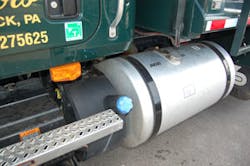As more and more trucks equipped with selective catalytic reduction (SCR) systems hit the road, fleets will need to keep closer tabs on diesel exhaust fluid (DEF) that makes SCR function properly in order to help minimize the impact of this new emissions control technology on their operating budgets.
“Greater price transparency always helps customers,” Chris Goodfellow, emissions analyst with global consulting firm Integer Research, explained to Fleet Owner in an interview via email.
“Keeping track of DEF pricing trends and changes on a regular basis will help fleets to build a ‘picture’ of how the product is priced and what the key drivers of price movements are in the areas in which they operate,” he said. “As fleets buy more and more SCR-equipped vehicles, this will become of increasing importance.”
According to Integer’s DEF consumption model, by the end of August this year over 6 million gallons of DEF were being consumed per month by some 200,000 Class 4 through 8 trucks now operating in North America.
DEF is a liquid solution comprised of 67.5% de-ionized water and 32.5% urea (an ammonia compound) that’s sprayed into an SCR-equipped truck’s exhaust stream where it combines with a catalyst to break down oxides of nitrogen (NOx) into nitrogen and water. Without DEF, the SCR system doesn’t reduce NOx emissions.
Ongoing surveys of the U.S. and Canadian transportation markets conducted by Integer finds that DEF availability is rapidly expanding, while the cost for this critical substance is dropping as well. The firm’s new “DEF Tracker” service, said Goodfellow, is designed to give U.S. fleets an easy way to manage and minimize the costs of acquiring the liquid for their operation.
The pricing data for this service is sourced from an extensive range of contacts within DEF distributors and fleets, with the data then analyzed by the price-reporting team at Integer, he noted. “This is something we’ve been doing in Europe for the last four years and in North America since the start of 2010,” Goodfellow added.
“DEF Tracker” reports pricing for bulk deliveries of the liquid (full TL and LTL alike), by tote and by 2.5 gal. jug price benchmarks for key Metropolitan Statistical Areas (MSAs) in the U.S. and Canada.
Initially, the cities covered by Integer’s “DEF Tracker” are: Houston, TX; New York, NY; Chicago, IL; Cincinnati, OH; Los Angeles, CA; and Toronto, Ontario, in Canada.
“We are also reporting pump prices at truck stops for each of the U.S. states and Canadian provinces that have locations available,” Goodfellow added.
At the end of November, according to Integer’s data, over 300 truck stops now offer DEF across North America. However, just four are based in Canada; the rest are located in the U.S. The average DEF price at the pump reached $2.73/gal. in the U.S. and roughly $2.92/gal. in Canada (some 80 cents Canadian per liter) by the end of last month.
“We also include the number of pump locations in these areas and a heat map of the U.S. to allow readers to visualize price changes across the states and Canadian provinces,” he noted.
Goodfellow also pointed out that Integer launched this service in response to demand for more regular pricing information from both DEF suppliers and buyers alike – especially to help fleets better understand and plan for DEF costs. “The pricing references have been designed to allow fleets and DEF suppliers to use them as valid DEF benchmarks when assessing their costs,” he said.
A free trial of DEF Tracker on Integer’s home page is available by clicking here.
About the Author
Sean Kilcarr
Editor in Chief
Sean Kilcarr is a former longtime FleetOwner senior editor who wrote for the publication from 2000 to 2018. He served as editor-in-chief from 2017 to 2018.
